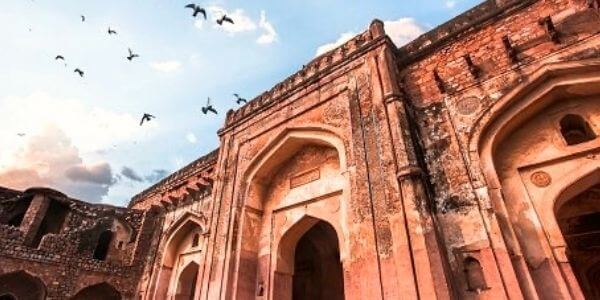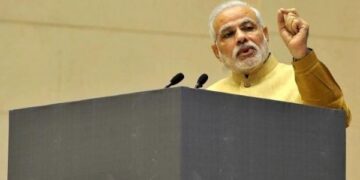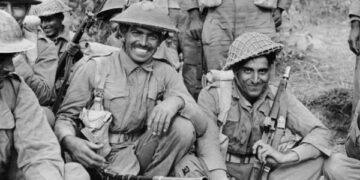The Mughal Empire is an important element of Indian history that can be used in competitive examinations such as UPSC-prelims, SSC, State Services, CDS, NDA, and Railways, among others. The Mughal reign began in the 16th century and lasted until the 19th century. In this post, we will cover the Mughal Empire Dynasty, including a list of all emperors in India, as well as who was the King and First Emperor.
- The Mughal Empire – Dynasty
- The Mughal Empire Kings
- Babur The First Mughal Emperor (founder of the Mughal empire)
- Humayun
- Akbar (The Mughal Dynasty's Most Popular Ruler of Mughal Empire)
- Jahangir
- Shah Jahan
- Aurangzeb
- Bahadur Shah I
- Jahandar Shah
- Furukhsir
- Rafi UL-Darjat
- Rafi Ud-Daulat
- Muhammad Ibrahim
- Muhammad Shah
- Ahmad Shah
- Alamgir II
- Shah Jahan III
- Shah Alam II
- Akbar Shah II
- Bahadur Shah II (Last Monarch of the Mughal Empire)
- Decline of the Mughals
- Conclusion- Mughal Empire
- FAQ- Mughal Empire
- Editor's Note | Mughal Empire
The Mughal Empire – Dynasty
They expanded their kingdom from Agra & Delhi in the second half of the 16th century until they dominated practically the whole subcontinent by the 17th century. They established administrative systems and governance principles that outlasted their authority, establishing a political legacy that successive subcontinent rulers could not ignore.
Who were the Mughals?
The descendants of the Mongol Empire who lived in Turkestan in the 15th century founded the Mughal Empire. They had become Muslims and embraced Middle Eastern culture while retaining their Far Eastern ancestry components. Mughals who dominated this Hindu subcontinent were Muslims. They are significant in Indian history. Mughals left several architectural gems behind, including the Red Fort, Taj Mahal, and others. Babur founded this empire. The Mughal Empire was founded after the Battle of Panipat. after Aurangzeb, it started to decline.
Don’t forget to look over this key topic for your UPSC exam: INDO PAK WAR 1971 | India – Pakistan | Heroes, Images, & Surrender. Let us now learn about all of India’s Mughal Emperors.

The Mughal Empire Kings
Babur, a descendant of Timur on his father’s side and Genghis Khan on his mother’s side, founded the Mughal Empire. The Great Mughal Emperors of India are given below.
Babur The First Mughal Emperor (founder of the Mughal empire)
- Babur, The very first Mughal ruler (1526- 1530)
- The political situation in northwest India was favorable for Babur’s entry into the country.
- Sikandar Lodi died in 1517, & Ibrahim Lodi took his place. I. Lodhi attempted to establish a strongly centralized kingdom, which concerned both Afghan leaders and Rajputs.
- As a result, in 1526, he beat the Sultan of Delhi, Ibrahim Lodi, and his Afghan followers at the First Panipat (War) and took control of Delhi and Agra.
- Babur’s creation of an empire in the Indo-Gangetic valley posed a challenge to Rana Sanga.
- So, in 1527, Rana Sanga, Rajput kings, and allies were defeated at Khanwa (Agra)
Babur was the first Mughal Emperor and the Mughal Empire’s creator.
Humayun
- In 1530, Humayun succeeded Babur.
- He had to deal with the Afghans’ quick rise to power and Gujrat’s Bahadur Shah.
- Sher Shah defeated Humayun & forced him to quit India at the battles of Chausa (1539) and Kanauj (1540).
- He took refuge with the Iranian king on occasion. Next to the disintegration of the Suri Empire, he recovered Delhi in 1555 but died the following year.
- Humayun founded a new city in Delhi called “Dinpanah.”
- The restored rule was more cohesive and effective than the 1530–1540 era. His son, Akbar, was given command of the united empire.
Akbar (The Mughal Dynasty’s Most Popular Ruler of Mughal Empire)
- At the time of Humayun’s death, Akbar was only thirteen years old. Because Akbar was in Punjab at the time his father died, his coronation took place in Kalanaur in 1556.
- His tutor and Humayun’s favorite and confidant, Bairam Khan acted as the Mughal emperor’s regent from 1556 to 1560.
- Akbar ruled over all of North India as a conqueror. Under his regent Bairam Khan, the Mughal empire expanded from Kabul to Jaunpur, including Gwalior and Ajmer, in the first four years of Akbar’s reign.
- Akbar defeated Rana Pratap in the Battle of Haldighati (1576) after most of the Rajput rulers accepted Akbar’s suzerainty.
- Muzaffar Shah, the ruler of Gujarat, was defeated by Akbar. He constructed the Buland Darwaza at Fatehpur Sikri to commemorate this victory.
- Akbar gradually expanded the Mughal Empire to encompass a large portion of the Indian subcontinent.
Akbar was The Mughal Dynasty’s Most Popular Ruler. His reign is divided into three parts:
- In 1556-1570, military campaigns were launched against the Suris & other Afghans and against the neighboring kingdoms of Malwa and Gondwana and to put down the revolt of Mirza Hakim, the Uzbeks. Chittor, the Sisodiya capital, was taken in 1568, and Ranthambhor in 1569.
- Gujarat’s military campaigns were followed by campaigns in the east in Bihar, Bengal, and Orissa from 1570 to 1585.
- Akbar’s empire expands from 1585 to 1605. Qandahar was taken from the Safavids, Kashmir was annexed, and Kabul was annexed. Campaigns began in the Deccan, and Berar, Khandesh, and parts of Ahmadnagar were annexed.
Jahangir
- Akbar’s military campaigns were carried on.
- When Akbar died in 1605, Prince Salim succeeded him as Jahangir (World Conqueror).
- His son Khusrau revolted but was defeated and imprisoned, and his supporter, the fifth Sikh Guru, Guru Arjun, was beheaded.
- Amar Singh, the Sisodiya ruler of Mewar, accepted Mughal service. Campaigns against the Sikhs, Ahoms, and Ahmadnagar were less successful.
- Relations with the British East India Company were established.
Shah Jahan
- Under Shah Jahan, Mughal campaigns in the Deccan continued.
- Khan Jahan Lodi, an Afghan nobleman, revolted and was vanquished.
- The battle to retake Balkh from the Uzbeks in the northwest failed, and Qandahar fell to the Safavids.
- Shah Jahan was imprisoned at Agra for the rest of his life by his son Aurangazeb.
Aurangzeb
- The Ahoms [an Assamese kingdom near the Brahmaputra Valley] were crushed in 1663 in the north. Still, they rebelled again in the 1680s because the Ahoms have successfully fought Mughal expansion for a long time and do not want to relinquish their 600-year-old sovereignty.
- Campaigns against the Yusufzai and the Sikhs in the northwest were temporarily successful.
- The Rathor Rajputs of Marwar rebelled because of Mughal interference in their succession and internal politics.
- At first, campaigns against Maratha chieftain Shivaji were successful. Shivaji, however, declared himself an independent king and resumed his battles against the Mughals after escaping from Aurangzeb’s jail.
- The Marathas and the Deccan Sultanates backed Prince Akbar[II] in his revolt against Aurangzeb.
- Aurangzeb led wars in the Deccan against the Marathas, who had begun guerrilla warfare beginning in 1698.
- Aurangzeb also had to deal with the Sikhs, Jats, and Satnamis revolting in north India. The Satnamis were a Hindu sect that despised Aurangzeb’s stringent Islamic policies, including resurrecting the despised Islamic Jizya tax (poll tax on non-Muslim citizens), prohibiting music and art, and destroying Hindu temples.
Babur and five of his lineal descendants became the first six Mughal kings: Humayun, Akbar, Jahangir, Shah Jahan, and Aurangzeb of the Empire.
Bahadur Shah I
- Due to a lack of leadership characteristics among his immediate successors, the empire continued to deteriorate after his rule. He let go of Shivaji’s oldest son, Shahuji, son of Shambuji.
Jahandar Shah
- Jai Singh of Malwa was given the title of ‘Mirza Raja,’ and Ajit Singh of Marwar was given the title of ‘Maharaja.’
- Ijara System (revenue farming/contract farming) was encouraged, and Jazia was abolished.
- Abdullah Khan and Hussain Ali (leaders of the Hindustani Party) were the first Mughal rulers to be slain in captivity by the Sayyid brothers.
Furukhsir
- During his reign, the manipulative Syed Brothers rose to power, and the rebel Banda was executed. He handed the English East India Company a Firman in 1717, guaranteeing them duty-free trading privileges in Bengal. Murshid Quli Khan, a well-known Murshid, denounced the Firman.
Rafi UL-Darjat
- Mughal Emperor number ten. The Syed Brothers proclaimed him Badshah after he replaced Furrukhsiyar.
Rafi Ud-Daulat
- In 1719, he was the Mughal Emperor for a short time.
Muhammad Ibrahim
- At the request of the Syed Brothers, Rafi Ul-brother Darjat’s attempted to seize the throne in order to remove Emperor Muhammad Shah.
Muhammad Shah
- Nadir Shah invaded India and pillaged the capital of Delhi. He also brought the fabled Kohinoor Diamond with him.
- With the support of the Sayyed Brothers, he became king, and later, with the help of Nizam-ul-Mulk, he assassinated them.
- In the Battle of Karnal, Nadir Shah was defeated.
- During his rule, Ahmad Shah Abdali also raided Delhi for the first time.
Ahmad Shah
- The only son of Mohd. Shah Rangeela.
- He was an inept ruler. Udham Bai was entrusted with the state’s affairs. The title of Qibla–i–Alam was bestowed upon her.
Alamgir II
- Imad-Ul-Mulk and his Maratha accomplice Sadashivrao Bhau plotted his assassination.
Shah Jahan III
- Prince Mirza Jawan Bakht deposed him following the Third Battle of Panipat.
Shah Alam II
- In 1764 AD, he was defeated in the Battle of Buxar and became known as ‘Ali Gauhar.’
- The third Battle of Panipat took place during his reign.
- He handed up all of his Diwani rights in Bihar, Bengal, and Orissa until 1772 when he regained them with the help of Mahaji Scindia.
- The first Mughal ruler to retire from the East India Company.
Akbar Shah II
- The first Mughal king to be protected by the British.
- During his reign, the Mughal Empire is reduced to merely the Red Fort.
Bahadur Shah II (Last Monarch of the Mughal Empire)
- He was the last monarch of the Mughal Empire and the son of Akbar II and Rajput princess Lal Bai.
- During his reign, the 1857 uprising occurred, and he was taken captive to Rangoon, where he died in 1862.
- His pen name was Zafar, and he was an excellent Urdu poet.
We went over the Mughal Empire Dynasty, including a list of all emperors in India and who the Mughal empire kings and First Emperor were.
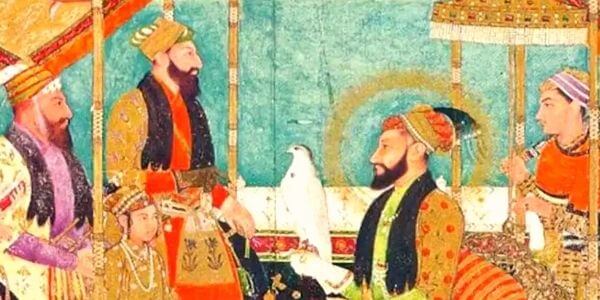
Decline of the Mughals
- After Aurangzeb, there was a lack of stability.
- The majority of the emperors became pawns in the hands of powerful Nobles, who frequently administered on their behalf.
- Nadir Shah and Ahmad Abdali’s invasion showed a weak military and governmental authority.
- The emergence of autonomous states and, as a result, the central power is weakened.
- Aurangzeb’s orthodox stance made the Marathas, Rajputs, and Jats his enemies. Hindus were also alienated by his religious policies.

Conclusion- Mughal Empire
We discussed the Mughal Empire Dynasty, which included a list of all Indian Mughal emperors as well as the Mughal Empire kings and First Emperor. For IAS Exam preparation, it is necessary to read the history of the Mughal rule. The NCERT History text for Class 7 is the primary source of information for this article (Our past -1). You can check out NCERT Books here. While reading the article, write a list of all points you find important.
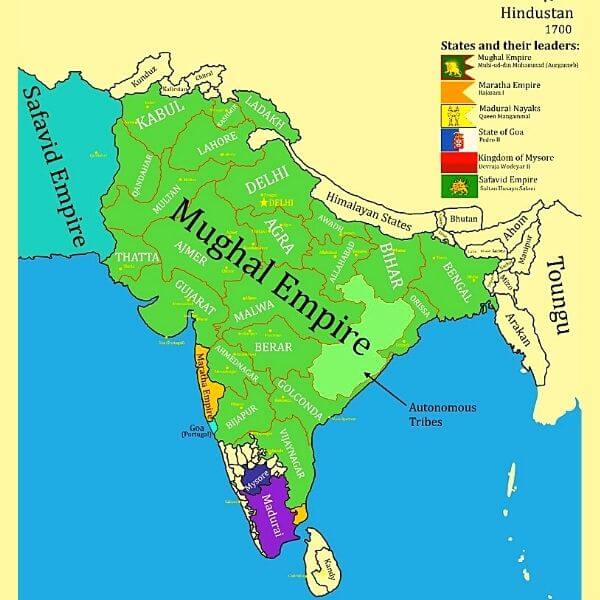
FAQ- Mughal Empire
The Mughal dynasty’s most famous members are its first rulers, Babur, and five of his lineal descendants: Humayun, Akbar, Jahangir, Shah Jahan, and Aurangzeb.
The First Battle of Panipat, fought in 1526, was lost by Ibrahim Lodi.
In 1582, Akbar established Din-I-Ilahi.
Editor’s Note | Mughal Empire
The Mughal Dynasty is discussed in this article on Medieval India. We have discussed the Mughals, Mughal empire kings, and the first Mughal emperor. Further, all the important points are discussed in this article. It is recommended that students read them carefully. Furthermore, completing as many question papers as possible will aid in acquiring knowledge and developing self-confidence. We wish you the best of luck in your UPSC exams.

